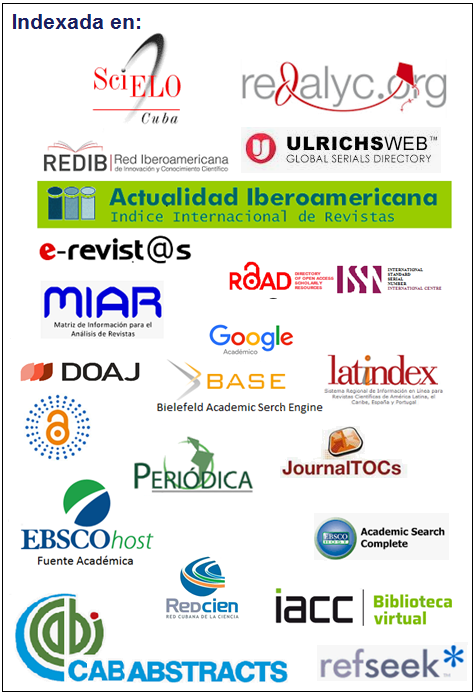Stochastic modeling of ground acceleration for eastern Cuba and the city of Santiago de Cuba
Keywords:
peak ground acceleration, stochastic modeling, shaking map, spectral accelerationAbstract
The southeastern region of Cuba is the most seismically dangerous area of the country because of its close location to the border of the Caribbean plate with the North American plate. This paper presents two possible scenarios of strong earthquakes, located about 30 km south of the city of Santiago de Cuba, in terms of peak ground acceleration (PGA) and spectral acceleration (PSA). Acceleration values were calculated for most of the municipalities in the eastern region and for several points in the city of Santiago de Cuba. Two earthquakes of magnitudes 7.0 and 7.3 were modeled, with epicenter in the Oriente fault zone. Necessary parameters were investigated in the calculations such as the stress drop and the attenuation function of the seismic waves. The results indicate significant rock accelerations in the municipalities of Santiago de Cuba and Guamá with values exceeding 180 cm/s2. A shaking map is also obtained for the city of Santiago de Cuba considering the spectral amplification of the soil. The maximum values of spectral acceleration for periods of 0.3 s reach 480 cm/s2.Downloads
References
Álvarez, L.; Lindholm, C. y Villalón, M. 2016: Seismic Hazard for Cuba: A New Approach. Bull. Seism. Soc. Am, 107(1): 229-239. doi: 10.1785/0120160074.
Boore, D. M. 2009: Comparing Stochastic Point-Source and Finite-Source Ground-Motion Simulations: SMSIM and EXSIM. Bull. Seism. Soc. Am., 99: 3202-3216.
Calais, E. y Mercier de Lepinay, B. 1991: From transtension to transpression along the northern Caribbean plate boundary off Cuba: implications for the Recent motion of the Caribbean plate. Tectonophysics, 186: 329-350.
Candia, G.; Macedo, J.; Jaimes, M. A. y Magna, C. 2019: A new State-of-the-Art Platform for Probabilistic and Deterministic Seismic Hazard Assessment. Seismological Research Letters, 90(6): 2262-2275.
Cotilla, M. O. y Córdova, D. 2010a: Notes on three earthquakes in Santiago de Cuba (14.10.1800, 18.09.1826, 07.07.1842). Russian Geology and Geophysics, 51: 228-236
Cotilla, M. O. y Córdova, D. 2010b: The August 20, 1852 earthquake in Santiago de Cuba, Russian Geology and Geophysics, 51: 1227-1246
Cotilla, M. O. 2003: The Santiago de Cuba earthquake of 11 june 1766: Some new insights. Geofísica Internacional, 42(4): 589-602.
D’Amico, M.; Tiberti, M. M.; Russo, E.; Pacor, F. y Basili, R. 2017: Ground‐Motion Variability for Single Site and Single Source through Deterministic Stochastic Method Simulations: Implications for PSHA. Bull. Seism. Soc. Am, 107(2): 966-983. DOI: 10.1785/0120150377.
Havskov, J. y Ottemoller, L. (Eds.) 2008: SEISAN, The earthquake analysis software for Windows, SOLARIS, LINUX and MACKINTOSH Version 8.2. Manual, Department of Earth Science, University of Bergen, Norway.
Moreno, B.; Grandison, M. y Atakan, K. 2002: Crustal velocity model along the southern Cuba margin: implications for the tectonic regime at an active plate boundary. Geophys. J. Int., 151(2): 632–645.
Mase, L. Z. 2020: Seismic Hazard Vulnerability of Bengkulu City, Indonesia, Based on Deterministic Seismic Hazard Analysis. Geotech Geol Eng 38, 5433–5455. DOI: 10.1007/s10706-020-01375-6.
Motazedian, D. y Atkinson G. M. 2005: Stochastic finite-fault modeling based on a dynamic corner frequency. Bull. Seism. Soc. Am., 95: 995-1010.
Rivera, Z. C.; Slejko, D.; Caballero, L. F.; Alvarez, J. L. y Santulin, M. 2015: Soil amplification in Santiago de Cuba. Journal: Atti del 34 Convegno Nazionale del Gruppo Nazionale di Geofisica della Terra Solida. Tema 2: Caratterizzazione sísmica del territorio. ISBN: 978-88-940442-6-3.
Sanò, T. y Pugliese, A. 1991: PSHAKE, Analisi Probabilistica della Propagazione delle Onde Sismiche. Ente per le Nuove Tecnologie, L’Energia e L’Ambiente (ENEA), Direzione Sicurezza e Protezione.
Sanò, T. 1996: BESOIL un programma per il calcolo della propagazione delle onde sismiche. Servizio Sismico Nazionale.
Sharbati, R.; Khoshnoudian, F.; Ramazi, H. R. y Amindavar, H. R. 2018: Stochastic modeling and simulation of ground motions using complex discrete wavelet transform and Gaussian mixture model. Soil Dynamics and Earthquake Engineering, 114: 267-280. DOI: 10.1016/j.soildyn.2018.07.003.
Wells, D. y Coppersmith, K. 1994: New empirical relationship among magnitude, rupture length, rupture width, rupture area, and surface displacement. Bull. Seism. Soc. Am., 84: 974-1002.
Zhang, Y.; Romanelli, F.; Vaccari, F.; Peresan, A.; Jiang, C.; Wu, Z.; Gao, S.; Kossobokov, V. G. y Panza, G. F. 2021: Seismic hazard maps based on Neo-deterministic Seismic Hazard Assessment for China Seismic Experimental Site and adjacent areas. Engineering Geology, 291. DOI: 10.1016/j.enggeo.2021.106208.
Published
How to Cite
Issue
Section
- Authors retain copyright and guaranteeing the right magazine to be the first publication of the work as licensed under a Creative Commons Attribution-NonCommercial that allows others to share the work with an acknowledgment of the work's authorship and initial publication in this journal.
- Authors may establish separate supplemental agreements for the exclusive distribution version of the work published in the journal (eg, place it in an institutional repository or publish it in a book), with an acknowledgment of its initial publication in this journal.
- Authors are allowed and recommended to disseminate their work through the Internet (e.g., in institutional telematic archives or on their websites) before and during the submission process, which can produce interesting exchanges and increase citations of the published work. (See The effect of open access)



